Team:Brown/Project S.epidermidis
From 2009.igem.org
The Chassis: Staphyloccocus Epidermidis
Staphylococcus epidermidis is an ideal vehicle for our genetic machine for several reasons: it is a native organism in the human nasal flora, it is generally non-pathogenic, and its sequenced genome is used with some frequency in lab work.
Since our gene of interest, rEV131, can only bind histamine if it is outside the cell, we have to engineer its secretion from S. epidermidis. We decided to use a signal peptide motif normally found on ß-lactamase, the S. epidermidis gene for ampicillin resistance, which uses the native Sec pathway for its secretion. We had the DNA sequence of this peptide synthesized and ligated it N-terminally to GFP as a test construct. This reporter would allow us to visually ascertain whether the produced protein was secreted. In our final genetic construct, the GFP reporter is replaced by rEV131.
AR-link to Part Registry of the secretion tag. Synth by Mr. Gene (kind sponsor of iGEM, etc.) Why did we think that using GFP was a good idea instead of an HRP or a color changing dye protein molecule? Was there something that we liked about GFP and EV131?
Quorum Sensor
Although Staphylococcus epidermidis is one of the more benign species of Staphylococcus, it can form infectious biofilms that are impervious to antibiotic treatment if its cell density becomes too great. This change in phenotype is accomplished by the S. epidermidis agr operon, which upregulates pathogenicity genes in response to a quorum. We reasoned that we could incorporate a safety mechanism into our bacteria by putting a death gene under the regulation of the agr promoter. This way, whenever the bacteria would reach a high enough density to become dangerous, they would simply begin to die until they reach a safer, lower density. In order to first test that our cassette works, we ligated the agr promoter upstream of GFP, so that whenever the cells reached a quorum, they would fluoresce green. Later, the GFP would be switched out for a CCDB, a death gene.
Staphylococcus epidermidis is not readily made chemically competent due to its thick cell wall. Most researchers use electroporation to induce cells to take up their target DNA. Throughout the course of our research, we have tweaked the electroporation protocol many times but there are always a very small number of transformants.
AR-link to the safety page from this section. Make clear what we did and have results for and what we continue to work on.
 "
"


